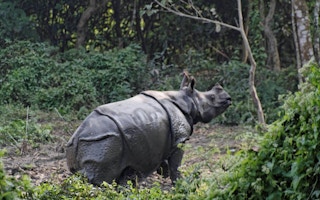Every monsoon season (June–August), Nepal’s Chitwan National Park becomes a no-go zone for tourists and locals alike. The park, home to the vulnerable one-horned rhinoceros (Rhinoceros unicornis), is flooded by the rivers that run through it, making it inaccessible and dangerous.
But the water also brings an unwelcome visitor: plastic waste. When the floods recede, plastic bottles, bags and sachets cover the river banks where the rhinos come to graze on the grass.
A recent study has found that rhinos ingest plastic items of different sizes and shapes, which could pose a serious threat to their health and survival. The study, published in the journal Global Ecology and Conservation, analyzed 258 dung samples from the park and found that 10.1 per cent of them contained visible plastic.
The researchers found plastic balls, soft drink bottle caps, chewing tobacco sachets, polythene bags, and biscuit, chocolate, and shampoo packaging in the dung. They also found that more dung samples from the core zone of the park, where human activity is restricted, contained plastic (18 per cent) than from the fringe zone (6 per cent), where people live and visit.
The findings come amid reports that almost all towns and villages in Chitwan dump their waste in landfills setup on the banks of the river. The waste piles up year-round and is washed away by the river during the monsoon floods.
“
We only looked at plastic that could be spotted with the naked eye. There may be smaller plastic particles that are doing the damage.
Balram Awasthi, researcher, Chinese Academy of Sciences
The results of the dung analysis suggest that the rhinos are not only eating plastic from the river but also from other sources, such as masks, tobacco packaging and bottle caps tossed away by visitors. They also indicate that the rhinos are moving between the zones and spreading plastic waste in the park.
“Chewing tobacco sachets (popularly known as ‘gutkha’ in South Asia) were the most pervasive compared to other items,” said Balram Awasthi, lead author of the study and a PhD student at the Chinese Academy of Sciences’ Xishuangbanna Tropical Botanical Garden.
Awasthi said he was surprised to find plastic in the dung when he was studying the ecological services that rhinos provide, such as seed dispersal. “As part of my study on the ecological services megafauna such as rhinos provide, I was looking at their dung when I found a lot of plastic in them,” he told Mongabay.
The study did not examine the long-term effects of plastic ingestion on the rhinos, but Awasthi said it could cause problems with their digestion, metabolism and reproduction. He said there have been reports of more rhinos dying from unknown causes in Chitwan, and plastic ingestion could be one of them.
“We only looked at plastic that could be spotted with the naked eye. There may be smaller plastic particles that are doing the damage,” he said.
Amir Sadaula, a veterinarian at Nepal’s semi-government body National Trust for Nature Conservation (NTNC), said it was concerning that plastic items were found in the dung of rhinos. “However, we don’t have evidence to suggest that rhinos have died by ingesting plastic,” he added.
Sadaula, who was not involved in the study, said that plastic could block the digestive tract of an animal or release harmful chemicals into its body. “That’s rarely been seen in rhinos,” he said. He added that more research is needed to assess the impact of plastic on the animals.
According to a census conducted by Nepal’s government in 2021, 752 one-horned rhinos live in Nepal’s wildlife sanctuaries, up from 645 in 2015. The species is listed as vulnerable on IUCN Red List of Threatened Species, with fewer than 2,200 individuals remaining in India and Nepal.
Awasthi suggested that the government and its conservation partners should conduct cleanup programs after the monsoon is over to remove plastic waste from the river banks. He also said towns and villages upstream should adopt sustainable waste management plans and practices to prevent plastic pollution in the rivers.
“Our research also shows that focusing cleanliness activities in the core areas doesn’t work as animals bring in waste from fringe areas as well,” he said.
This story was published with permission from Mongabay.com.










